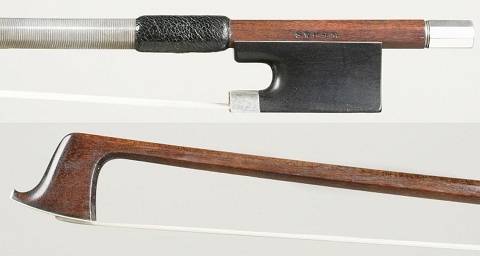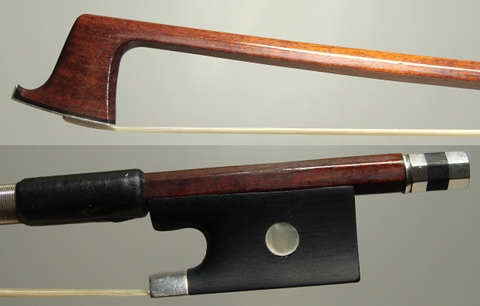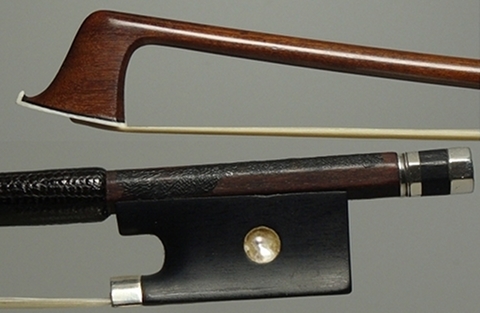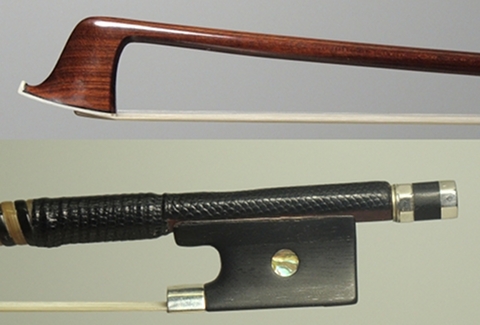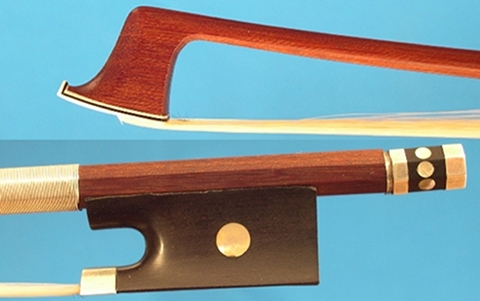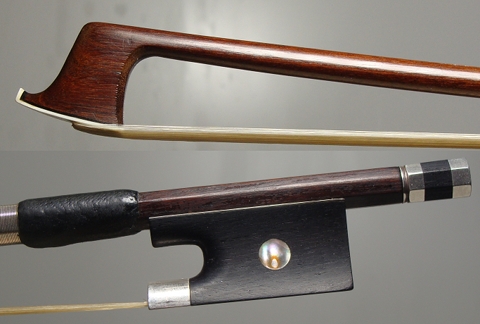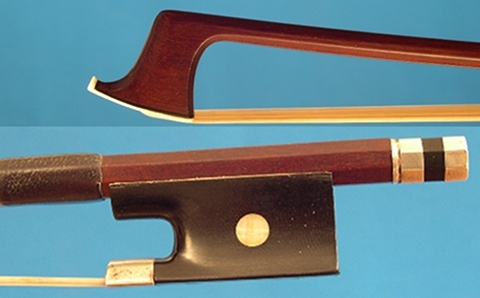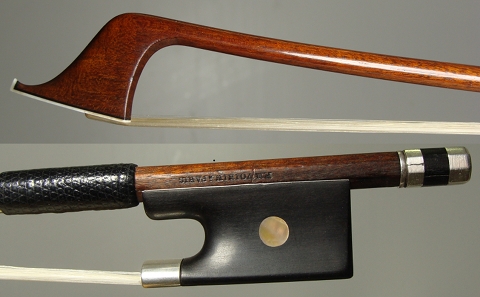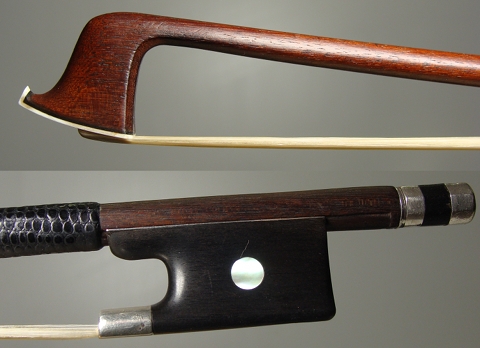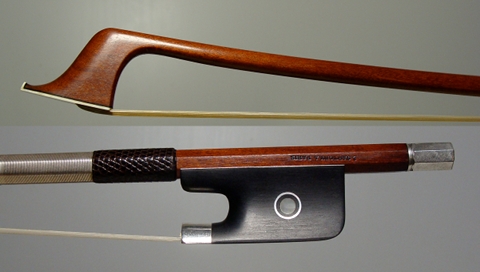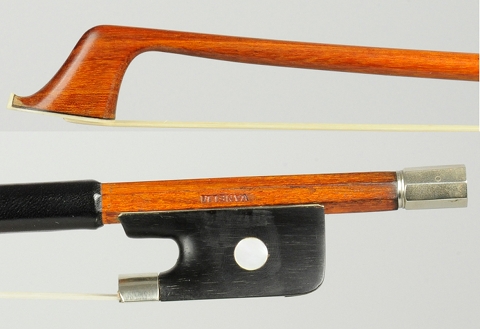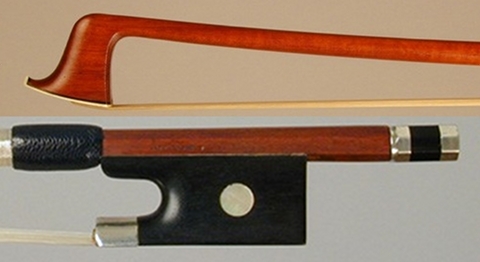W. E. HILL AND THE SCHOOLSSome time ago CR. Forma – the education services in the province of Cremona organized a very interesting conference, which I must thank for, on the development of the English school of bow making. The conference was held by one of the leading names at the moment; M° Tim Baker. He supplied very important information on the different periods and information on construction technics, and it led me to a comparative reflection on the Anglo-Saxon way – especially the W.E. Hill way – and the French schools way on teaching.
Viola bow by W. E. Hill in silver and nude ebony The first interesting thing Mr. Baker had to say was referred to the mysteries transitional violin bow: the famous Cramer model. He, as M° J.F. Rafin, was not able to say where this particular model was developed. He confirmed that the first bows, made in England by Dodd, with this type of model was made with curve. The bow Mr. Baker showed was dated 1770/75, therefore certainly after the year that the Cramer model went to Paris to carry out the Concert Spirituel (1769), and at the same time making it known to Nicolas Léonard Tourte. We don't know for sure if it was Cramer who introduced this model in England, he didn't transfere there until 1774. The second interesting information was in fact about the curves. Unlike the French school, the English school never left the initial curves. Although the Industrial Revolution had had its beginning, the english bow makers did not let themselves ensnare by the new Voireniane mechanics. They were made with the purpose to fasten up production at the expense of the functionality of the bows. This is the reason why the english bows had an increasing success, which then had its pick in the first half of the 19th century. Another aspect I find very interesting in the english tradition of bow making, is the production way and the way they teach. W. E. Hill & Sons was an atelier and a school. One would attend a period of apprenticeship which would then be followed up by an assumption in the workshop. This way of working was very similar to the very famous French workshop of Jean Baptiste Vuillaume. He also had young and promising boys, like Dominique Peccatte, who was entrusted to more expert craftsmen to complete his training. Though there was a fundamental difference. It is possible to know every detail of a bow made in the workshop of W. E. Hill & Sons: like who made the bow and in what year, allowing a clearer assessment of the object. Every bow maker that worked by the Hills, had a personal identification number shown both on the stick as on the frog - to times made by different craftsmen. Now this system helps us when valuing the bows these days, and it gave Hill the possibility to maintain a high level of quality. First of all because he knew who had made what parts and therefore he knew how it was made. Second because the craftsmen was motivated to give the best of themselves, thanks to this number they could claim the quality of there work outside work as well. A classic example was James Tubbs who marked, with his personal timbre, all the bows he could get his hands on, which he had made years earlier for Hill. When dealing with Vuillaume it is necessary to trust experts and their certifications; this is the most clear example. Often one find bows with marks which seems without correlation to the hands who made them.
Viola bow by Francois Xavier Tourte No expert would never correlate Tourte and Persoit, even though it is practically impossible that they didn't know each other and that Tourte haven't given any work to Persoit. The first bows made by Persoit which are photographed in the book “L'Archet” goes back to 1823, which was the year Persoit entered the newly established Vuillaume workshop. It would be strange if this man never made anything previously, first of all because at the time he was more than forty years old, second because only three years later on, in 1826, he was entrusted Dominique Peccatte as a student. The motive to this mystery is surely to be found in the price list of these two craftsmen; a Persoit costs about half.
Violin bow by Jean Marie Persoit
We must not forget Etienne Pajeot, who was a great genius of bow making at the time. He also didn't work alone. When he started his workshop in 1815, he assumed Fonclause and Maire to work in his name. Fonclause left the workshop in 1830, whereas Maire remained until his death in 1849. It would be difficult to find a certificate with the writing: “Made by Claude Joseph Fonclause for Etienne Pajeot”. And so, not long ago in a comparison amongst experts valuing a certificate of a bow certificated Pajeot, a laughter aroused by all the present; it was surely made completely by Fonclause.
Violin bow by Joseph Fonclause
Violin bow by Dominique Peccatte (frog copy) Dominique Peccatte had his collaborators as well. It is known that in his workshop Simon and Henry worked there, more or less, on a regular basis. If you observe the bows you would be able to identify perfectly who made the bows; obviously this is almost never on the certificates. It is more difficult to establish with whom Dominique Peccatte collaborated when he returned to Mirecourt, in 1847. Mirecourt where he stayed until his death. On a start with his brother, but surely there were others as well.
Violoncello bow by Nicolas Voirin Francois Nicolas Voirin; though he passed away very early, he taught and gave work to Thomassin and Lamy Père; they even went on making bows for the widow. The “Voirin de la veuve” are famous. These last ones are usually well credited in the certificates.
Violin bow by Jean Joseph Martin Martin; this case is obvious. Before he failed in 1881 he had a production of 1800 bows a year, even so, the craftsmen were often not in the certificates. I believe it is quite impossible that he made all the bows by himself.
Violoncello bow by Eugéne Sartory Or what about the wizard Circe; the year of making. It is known that Sartory gave work to more than one colleague, though I have never seen a certificate quoting any collaboration – only the year of making. 1890, 1910, 1925, 1935; the problem is that one doesn't know with whom Sartory collaborated in those years, only they did.
Violoncello bow by Louis Bazin The extreme case; the Bazin. What can I say, some time ago I showed a bow to a French expert. While he was looking at it, I tentatively claimed that it could be a Lapierre. He immediately denied: ”No, no it is a Louis Bazin”. Note: Marchel Charles Lapierre worked by Louis Bazin for ten years.
Violin bow by Louis Morizot père How can one forget about the Morizots. The old Louis and his sons gave work to an entire generation of bow makers, and not only. He also worked for many different people including Charles Nicolas Bazin and the more famous Parisian colleague, Sartory. This last one sued him for writing on the entrance of his workshop “Already working for Eugène Sartory”. Unfortunately all this leaves too much room for speculation. When those who certificates are aware that the bows are not pure, and they estimate lower, the merchant are still free to sell the bows to inexperienced buyers, as if it was made by the craftsman marked on the bow. Therefore as it happened to Persoit, who has become known only in the last ten years, the risk is that some of the most important names of this profession disappears. The news is that M° J.F. Rafin is valuing a new certification method, to reduce the possibility of making mistakes when rating the bows. I am confident in the great capacity of the Master. So long, Paolo To read more about this topic: NICOLAS LEONARD TOURTE DIT "L'AINE"; THE BROTHER FRANCOIS XAVIER TOURTE 1820-25 ETIENNE PAJEOT; THE THOUSAND HEADED BOWMAKER CLAUDE JOSEPH FONCLAUDE; THE NICE DOMINUQUE PECCATTE; THE PURE ONE PIERRE SIMON; THE NICE PECCATTE FRANCOIS NICOLAS VOIRIN; THE PERFECT BALANCE J. J. MARTIN; THE LAST GREAT ONE CHARLES NICOLAS BAZIN; THE FOUNDER JOSEPH ALFRED LAMY "PERE"; THE LINK
|
   |






